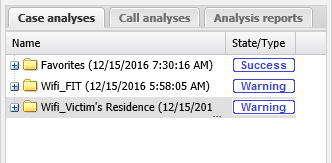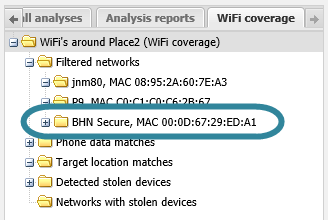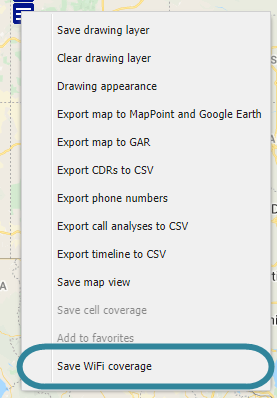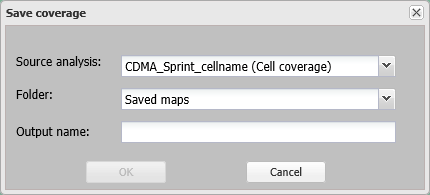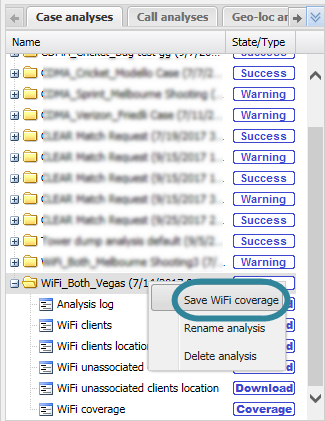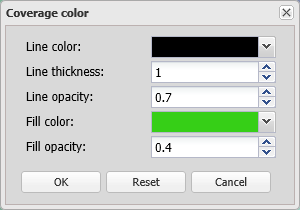Viewing WiFi footprint analysis results
This topic describes how to view WiFi footprint analysis results.
The WiFi footprint analysis is displayed on the ESPA analysis center screen's Case analyses tab. By default the analysis generates the WiFi coverage and also an analysis log download. From the Case analyses tab you can open the WiFi coverage result. The WiFi coverage opens results on both the WiFi coverage tab and the WiFi networks tab:
- on the WiFi coverage tab the results displayed detail the Filtered networks which is the WiFi networks of interest that you identified using the WiFi footprint analysis dialog box, such as the WiFi networks surrounding a target location. From this tab you can select which components of the WiFi coverage you want displayed on the map. Also displayed are results for: Detected stolen devices if your administrator has known stolen devices configured; Phone data matches if the case has phone data uploaded to it; and any other results you selected prior to running the analysis such as Target location matches.
- on the WiFi networks tab the results displayed detail all the WiFi networks included in the analysis. WiFi networks on this tab can be added to the WiFi coverage tab if required.
Running a WiFi footprint analysis requires option E12 WiFi data/analytics. If you do not have this option, Analysis is not available on the Input and settings view of the ESPA analysis center screen.
After you have run your analysis as described in Preparing WiFi footprint analysis evidence you can view the results once the analysis has completed successfully. You will know when your analysis is complete when the state of your analysis on the Case analyses tab changes to Success or Warning.
You can view the WiFi coverage results using either of the following procedures:
- Open your case on the ESPA analysis center screen and set the map to display the case information you require, such as the desired phone numbers and the date range.
-
On the Case management view's Case analyses tab click the analysis folder you want to review the results for. The folder opens and displays the result outputs.
- To display on the map the WiFi coverage detected in the drive test click WiFi coverage then select Open. The WiFi coverage tab and the WiFi networks tab opens.
-
If you are using the WiFi coverage tab then click to open any folder you are interested in viewing the results for. You can display a variety of WiFi drive data on the map, including each WiFi network's signal trail, and if available their signal area and signal contours. To do this select the drive data you want to display, then click Zoom to this. The map zooms to display the selected drive data.
For further information on the WiFi coverage selections refer to WiFi coverage tab.
-
If you are using the WiFi networks tab then, for all WiFi networks detected during the drive:
-
To display a variety of WiFi drive data on the map, including each WiFi network's signal area, signal contour and signal trail:
For the WiFi network of interest, select the required checkbox in either the Signal area, Signal contour or Signal trail columns.
-
To display the WiFi network 's location:
For the WiFi network of interest, select the required checkbox in the column next to the Zoom to column. The location is displayed on the map by
 .
. -
To center a specific WiFi network on the map:
For the WiFi network of interest, click Zoom.
-
To add WiFi networks to the WiFi coverage tab's Filtered networks folder:
For the WiFi networks of interest, select the required checkboxes in the column next to the Zoom to column then click Add to filtered networks.
-
When you run your analysis as described in Preparing WiFi footprint analysis evidence you may have included a file identifying selected networks you wanted added to your Filtered network folder. After the analysis is complete you can also add additional networks to the Filtered networks folder using the following procedure.
- View your WiFi coverage results as described in How to view WiFi coverage results.
-
On the WiFi network tab use the checkboxes next to the Zoom to column to select the networks of interest, then click Add to filtered networks.
The selected networks are then added to the WiFi coverage tab's Filtered networks folder.
If you want to save the WiFi coverage configuration that you currently have displayed use either of the following procedures:
Click
 then select Save WiFi coverage.
then select Save WiFi coverage.The Save coverage dialog box opens.
- In Folder select which folder you want to save the WiFi coverage configuration to. The folders that are available to select are that of the WiFi coverage analysis you have open and of those you manually created on the Case analyses tab. There is also a folder named Saved maps which creates a new folder with that name if it is not already created, or you can enter your own folder name.
- In Output name enter a name for your WiFi coverage map then click OK. Your new WiFi coverage map is saved and displayed on the Case management view on the Case analyses tab under the folder you selected.
On the Case analyses tab select the folder you want the WiFi coverage configuration saved to and select Save WiFi coverage.
The Save coverage dialog box opens.
NOTE: Save WiFi coverage is only displayed for folders that currently have a WiFi coverage result open on the WiFi coverage tab.
- In Folder select which folder you want to save the WiFi coverage configuration to. The folders that are available to select are that of the WiFi coverage analysis you have selected and of those you manually created on the Case analyses tab. There is also a folder named Saved maps which creates a new folder with that name if it is not already created, or you can enter your own folder name.
- In Output name enter a name for your WiFi coverage map then click OK. Your new WiFi coverage map is saved and displayed on the Case management view on the Case analyses tab under the folder you selected.
You may want to change a coverage's appearance if the automatic selection of colors has placed coverages of a similar color side by side making the individual footprints difficult to distinguish between. This is also useful if you are creating reports and taking screen captures of the map where you want it to highlight specific coverages of interest as it also allows you to adjust the thickness of the coverage's boundary lines. You can edit the outline and fill of specific cells using the following procedure.
- Open the WiFi coverage tab as described in How to view WiFi coverage results and ensure it displays the case information you require, such as the desired phone numbers and the date range.
-
On the WiFi coverage tab, for each WiFi network you want on the map, select the Signal area then click the output and select Edit coverage color. The Coverage color dialog box opens.
-
Edit the settings as required then click OK. The dialog box closes and the WiFi network's coverage appearance is updated on the map.
